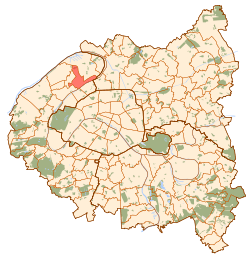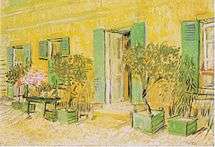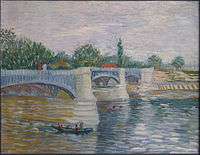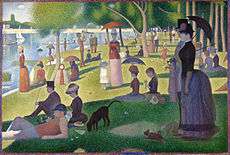Asnières-sur-Seine
| Asnières-sur-Seine | ||
|---|---|---|
| Commune | ||
 Château d'Asnières | ||
| ||
 Paris and inner ring départements | ||
| Coordinates: 48°54′39″N 2°17′20″E / 48.9108°N 2.2889°ECoordinates: 48°54′39″N 2°17′20″E / 48.9108°N 2.2889°E | ||
| Country | France | |
| Region | Île-de-France | |
| Department | Hauts-de-Seine | |
| Arrondissement | Nanterre | |
| Canton | Asnières-sur-Seine, Courbevoie-1 | |
| Intercommunality |
Métropole Grand Paris ÉPT Boucle Nord Seine | |
| Government | ||
| • Mayor (2015-2020) | Manuel Aeschlimann | |
| Area1 | 4.82 km2 (1.86 sq mi) | |
| Population (2015)2 | 86,512 | |
| • Density | 18,000/km2 (46,000/sq mi) | |
| Time zone | UTC+1 (CET) | |
| • Summer (DST) | UTC+2 (CEST) | |
| INSEE/Postal code | 92004 /92600 | |
| Elevation | 22–43 m (72–141 ft) | |
|
1 French Land Register data, which excludes lakes, ponds, glaciers > 1 km2 (0.386 sq mi or 247 acres) and river estuaries. 2 Population without double counting: residents of multiple communes (e.g., students and military personnel) only counted once. | ||
Asnières-sur-Seine (French pronunciation: [a.njɛʁ syʁ sɛn]) is a commune in the northwestern suburbs of Paris, France, along the river Seine. It is located 7.9 km (4.9 mi) from the center of Paris.
Name
Asnières-sur-Seine was originally called simply Asnières. Asnières was recorded for the first time in a papal bull of 1158 as Asnerias, from Medieval Latin asinaria, meaning "donkey farm". The poor soil of Asnières, where heather grew in Medieval times, was probably deemed only suitable for the breeding of donkeys. By the early 20th century it had become a favourite boating centre for Parisians, and its industries included boat building.[1]
On 15 February 1968 the commune was officially renamed Asnières-sur-Seine (meaning "Asnières upon Seine"), in order to distinguish it from other communes of France also called Asnières.
Demographics
Immigration
| |||||||||||||||||||
Administration
Asnières-sur-Seine is divided into two cantons:
- Asnières-sur-Seine-Nord: 43,453 inhabitants (57.3% of the total).
- Asnières-sur-Seine-Sud: 32,384 inhabitants (42.7% of the total).
Economy
Different famous companies are located in Asnières:
- L'Oréal - cosmetics
- Lucas
- Lesieur
- Louis Vuitton - luxury products
The Cimetière des Chiens is believed to be the first zoological necropolis in the world.
Education
Public schools in the commune:
- 20 preschools (maternelles)[2]
- 16 elementary schools[3]
- 4 junior high schools: André Malraux, Auguste Renoir, François Truffaut, and Voltaire[4]
- Senior high schools: Lycée Auguste Renoir, Lycée professionnel de Prony, and Institut départemental médico-éducatif Gustave Baguer[5]
Private schools:
- Institution Sainte-Geneviève (preschool through senior high school)[2]
- Institution Saint-Joseph (preschool through junior high school)[2]
- École catholique Sainte-Agnès (preschool and elementary school)[2]
University of Paris III: Sorbonne Nouvelle serves as the area university.[6]
Sports
In addition to the Courtilles ice rink, the town has ten gyms, six stadiums, a shooting range, two tennis clubs (Azur Tennis Club and the Tennis Club du Ménil), a skate park, a Parisian boules court and a swimming pool.
The Asnières Volley 92 participates in Ligue B (2nd national level) and plays at the Courtilles gymnasium. The city also has a handball club in agreement with neighboring cities. For the 2017-2018 season, the first team evolves in Pool 2 in National 2. Finally, the city counts, with the Molosses, an American football club, created in 1992, evolving in Casque d'Or (D2), 2-time vice-champion of France of D1 (1999, and 2014).
A full-contact club, known as ABC (Asnieres Boxing Club) is also managed by a coaching team composed with ex-France and European champions. Around 100 members take part in trainings three times a Week (Monday, Wednesday and Friday). The judo and jujitsu club Arts Martiaux d'Asnières uses several of the town's gyms.[7]
Transport
Roadways
Car traffic in Asnières is difficult. Most of the traffic is on the banks of the Seine around the city. The crossing of the Asnières bridge is extremely painful during peak hours. The Grand rue Charles-de-Gaulle then the Avenue d'Argenteuil are also difficult to pass because serving Bois-Colombes and northern towns. Moreover, the city has very few parking spaces, and garages and private parking spaces are scarce and expensive.
Between 2010 and 2013, there was a development plan to change the streets of the city being one-way and become practicable in both directions for bicycles.
Public transportation
Asnières-sur-Seine is served by three stations on Paris Métro Line 13 : Gabriel Péri, Les Agnettes and Asnières – Gennevilliers – Les Courtilles, terminus of the line.
The tramway line 1 also serves Asnières – Gennevilliers – Les Courtilles station, connecting to Noisy-le-Sec.
It is also served by Asnières-sur-Seine and Bois-Colombes stations on the Transilien Paris – Saint-Lazare suburban rail network. Lines J and L can be used.
A number of bus lines cross the town to connect it with its neighbours : lines 165, 175, 177, 276, 140.
Art
Georges Seurat
Bathers at Asnières by Georges-Pierre Seurat depicts a scene of 19th century leisure and developing industry in this suburb of Paris.
In 1885 Seurat made Sunday Afternoon on the Island of La Grand Jatte used a technique of placing colored dots on a work which led a movement called "Pointillism".[8]
Vincent van Gogh


Summer, 1887
Kansas City, Nelson-Atkins Museum of Fine Art (F355)

Vincent van Gogh made a series of paintings of Asnières. Influenced by Impressionism and Pointillism, van Gogh modified his traditional style and used vivid color, shorter brushstrokes and perspective to engage the viewer. His views of the banks of the Seine are an important progression for his later landscape paintings.[9][10] In Asnières, within walking distance of Theo's flat in Montmartre, van Gogh painted parks, cafés, restaurants and the river.[11]
Notable residents
The old château was the death place of Anne Marie Victoire de Bourbon (1675–1700), daughter of Henri Jules de Bourbon and thus grand daughter of le Grand Condé, cousin to Louis XIV.
Asnières was the birthplace of
- the cyclist Gaston Rivierre (1862–1942)
- Henri Barbusse (1873–1935), politician and writer of Under Fire. A street in the town was named after him.
- the violinist and teacher Marcel Chailley (1881–1936)
- the violinist Maurice Hewitt (1884–1971)
- the composer Ginette Keller (born 1925)
- the actor Frédéric Gorny (born 1973)
- the football player William Gallas (born 1977)
- the football player Axel Ngando (born 1993)
The Franco-Irish composer and pianist George Alexandre O'Kelly died here in 1914.
See also
Notes
- ↑

- 1 2 3 4 "Ecoles maternelles." Asnières-sur-Seine. Retrieved on September 7, 2016.
- ↑ "Ecoles élémentaires." Asnières-sur-Seine. Retrieved on September 7, 2016.
- ↑ "Les collèges publics." Asnières-sur-Seine. Retrieved on September 7, 2016.
- ↑ "Les lycées publics." Asnières-sur-Seine. Retrieved on September 7, 2016.
- ↑ "Vie scolaire." Asnières-sur-Seine. Retrieved on September 7, 2016.
- ↑ "A.M ASNIERES". ffjudo.org (in French). Retrieved 2017-11-06.
- ↑ The First Moderns: Profiles in the Origins of Twentieth-century Thought, p. 63–64, at Google Books
- ↑ Hansen; Nichols; Sund; Knudsen; Bremen (2003). Van Gogh: Fields. Hatje Cantz Publishers for Toledo Museum of Art Exhibition. p. 10. ISBN 3-7757-1131-7.
- ↑ "The Seine with the Pont de la Grande Jatte, 1887". Permanent Collection. Van Gogh Museum. 2005–2011. Retrieved 2011-04-30.
- ↑ "Restaurant at Asnières, 1887". Permanent Collection. Van Gogh Museum. 2005–2011. Retrieved 2011-04-30.
References
External links
| Wikimedia Commons has media related to Asnières-sur-Seine. |
- Asnières-sur-Seine official website (in French)
.svg.png)

